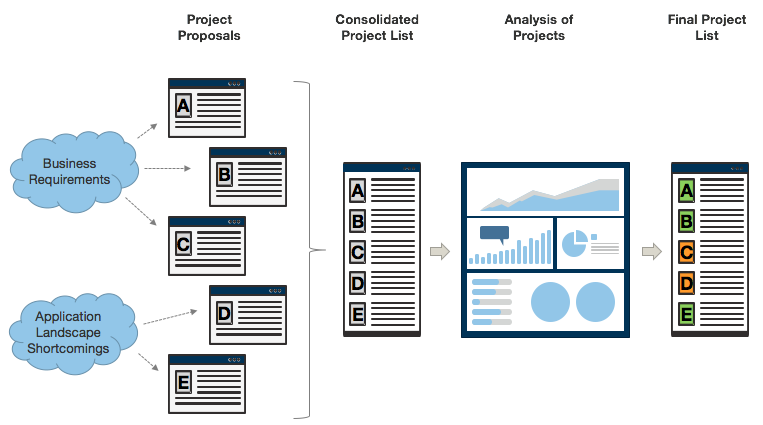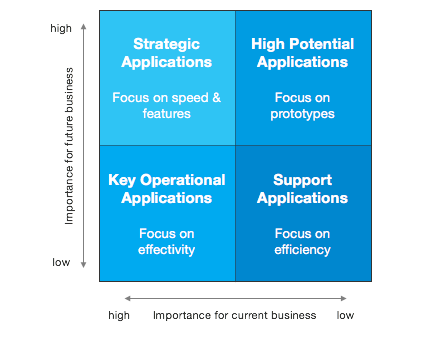The goal of portfolio management is to decide which projects with an impact on the EA should be implemented based on their expected benefits [Nie08].
Portfolio management can take three different forms [Kel11]. One form is the classical project portfolio management, which constitutes a process for deciding which projects to implement [Kel11]. The second kind is the application portfolio management which aims at optimizing the application portfolio of an enterprise [Kel11]. The last form is the infrastructure portfolio management [Kel11]. This kind of portfolio management aims at optimizing the available infrastructure the applications run on [Kel11]. Note that projects chosen by the project portfolio management have impact on the future application and infrastructure portfolio [Buc+09b]. All forms of portfolio management are reoccurring processes.
Portfolio Management is a wicked problem to be solved collaboratively between business and IT [Nie08]. Since Enterprise Architects have a good overall-picture of the enterprise, they should take a role as advisors and assessors [BBL12]. This way they can, for example, identifying common IT needs across the business units and prioritize projects based on architectural fit [BBL12].
During the project portfolio process a prioritization schema is applied to the list of proposed projects yielding a set of approved projects [Kel11]. A generic example of a project portfolio management process is illustrated in Figure 1.

Figure 1: Generic Portfolio Management Process.
The starting point of project portfolio management are the project proposals, which can be motivated based on business requirements or based on possible shortcomings of the current application portfolio. Usually, a template needs to be filled in for each project proposition, containing a short description, the expected benefit, risks, costs and other information to enable an overview over and a comparison of the projects [Wit+07]. Based on these proposals, a consolidated list of all proposed projects is created, which summarizes similar projects and highlights dependencies between them and with ongoing projects.
Since usually there is not enough budget available to finance all projects, in the next step, projects are analyzed and prioritized. They can be evaluated regarding their monetary and strategic importance for the business or with regards to improved quality of the application portfolio. This prioritization process should be based on a consistent framework applied to all project evaluations [BBL12].
In the last step, the projects with the most benefit for the company are chosen by allocating budget and resources [Nie08]. The goal is to maximize the efficiency of investments into the application portfolio. One possible approach supporting the choice of projects to be implemented is the managed evolution approach.
A business application can be defined as being a deployment of a software system in a certain version at a distinct location and hardware with a clear relationship to at least one business process of the organization [Buc+08a]. The entirety of employed business applications and their relationships make up the application portfolio of an organization, which is an important asset providing critical support functions for the business [BMS09a]. Sometimes the terms software city or IT application landscape are used as synonyms for application portfolio [Hes+07]. The management of the application portfolio is an important task which can be addressed using EAM processes [BMS09a].
Due to its importance, a couple of different approaches to application portfolio management have been developed in practice and academia [Buc+09b]. A renown approach is the use of a categorization matrix proposed by Ward & Peppard (2016), which classifies the applications of an application portfolio according to their impact on the current and the future business [WP16]. Depending on which category they are assigned to, the applications are treated in different ways [Kel11]. The matrix is illustrated in Figure 2.

Figure 2: Classification matrix for business applications. [Based on: J. Ward and J. Peppard. The Strategic Management of Information Systems: Building a Digital Strategy. John Wiley and Sons, 2016.]
An application is categorized as being a support application if it provides little contribution to the current or the future bottom line of the business. Those applications are commodities, and therefore strategies focusing on efficiency should be applied. Examples for such strategies are standardization or outsourcing. If an application provides high value to the current business but does not provide a strategic fit in the future, is is classified as being a key operational application. Those applications are usually large systems, that the current business relies on and where down-time is costly. Therefore, the focus should lie on strategies fostering effectiveness of these applications. Strategic applications are applications which support products that will be future cash cows. The emphasis for those applications is still on speed and on features and not so much on effectiveness or efficiency. Finally, applications supporting new products in the development and test phase are high potential applications. Those applications are usually still in their prototype phase [WP16].
Similar to the application portfolio management, infrastructure portfolio management is usually approached by categorizing infrastructure elements according to their impact on the current and future business. The major difference is that infrastructure usually isn’t a matter of competitive advantage. Thereby infrastructure portfolio management efforts mostly aim at reducing heterogeneity and complexity with the goal of enabling lower your maintenance and administration costs [Kel11].
Sources:
| [Nie08] |
K. Niemann. “Enterprise Architecture Management and its Role in IT Governance and IT Investment Planning.” In: Advances in Government Enterprise Architecture. IGI Global, 2008, pp. 208–228. |
| [Kel11] |
W. Keller. TOGAF 9.1 Quick Start Guide for IT Enterprise Architects. Tech. rep. Wolfgang W. Keller, 2011. |
| [BBL12] |
S. Bente, U. Bombosch, and S. Langade. Collaborative Enterprise Architecture: Enriching EA with Lean, Agile, and Enterprise 2.0 Practices. Elsevier, Inc., 2012. |
|
[Buc+09b] |
S. Buckl, A. M. Ernst, F. Matthes, and C. M. Schweda. “An Information Model for Managed Application Landscape Evolution.” In: Journal of Enterprise Architecture (JEA) (2009), pp. 12–26. |
|
[WP16] |
J. Ward and J. Peppard. The Strategic Management of Information Systems: Building a Digital Strategy. John Wiley and Sons, 2016. |
|
[Wit+07] |
A. Wittenburg, F. Matthes, F. Fischer, and T. Hallmermeier. “Building an integrated IT governance platform at the BMW Group.” In: Int. J. Business Process Integration and Management 2.4 (2007). |
|
[Buc+08a] |
S. Buckl, A. Ernst, J. Lankes, and F. Matthes. Enterprise Architecture Management Pattern Catalog (Version 1.0, February 2008). Tech. rep. TB0801. Chair for Informatics 19 (sebis), Technische Universität München., 2008. |
|
[BMS09a] |
S. Buckl, F. Matthes, and C. M. Schweda. “Classifying enterprise architecture analysis approaches.” In: IFIP-International Workshop on Enterprise Interoperability. Berlin Heidelberg: Springer, 2009, pp. 66–79. |
|
[Hes+07] |
A. Hess, B. Humm, M. Voss, and G. Engels. “Structuring software cities a multidimensional approach.” In: 11th IEEE International Enterprise Distributed Object Computing Conference (EDOC), 2007. IEEE. 2007, pp. 122–129. |